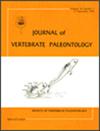来自德克萨斯州上白垩纪的一只泰坦巨龙(恐龙,蜥脚类)的椎骨、肋骨和髂骨的充气模式和功能本文引用自:Fronimos, J. a .(2023)来自德克萨斯州上白垩纪的一只泰坦巨龙(恐龙,蜥脚类)的椎骨、肋骨和髂骨的充气模式和功能。古脊椎动物杂志。https://doi.org/10.1080/02724634.2023.2259444
IF 1.9
4区 地球科学
Q2 PALEONTOLOGY
引用次数: 0
摘要
许多蜥脚类恐龙表现出广泛的颅后骨骼充气,这可能促进了极端体型的进化。在兽鼻龙中,复杂的、不规则的分叉的茶树状腔遍布骶前脊柱,经常侵入肋骨和髂骨。为了探索这些camellae的功能,包括减少骨骼体积,研究人员对来自德克萨斯州大本德国家公园上白垩纪黑峰地层的一只雷龙蜥脚类动物进行了气动检查,其中包括气动背肋骨和ilia。使用自然断裂非破坏性地观察内部结构,描述了背椎骨、肋骨和髂骨的驼峰状通气模式。本文首次在一种蜥脚类动物中报道了将山驼峰所占空间量化为空间比例。部分背椎和髂骨的空域比例超过70%,靠近椎中心的子叶和髋臼的空域比例较低。肋骨的值远端降低。这些值与具有较简单照相机气动的蜥脚类动物的值没有明显的不同。如果camellae没有提供比照相机更大的重量减轻,它们可能增强了结构强度,因为腔室似乎与椎中央和髂骨的应力对齐。然而,髋臼周围的气动小梁骨、髋臼前突和颧骨后,可能表明压力太大,茶骨无法承受,尽管不能排除个体发生的影响。感谢T. M. Lehman让我有机会研究这个样本,并指导了项目的初步方向。资料的收集得到了A. Brink, J. Browning, D. Evans, J. Schubert和S. Wick的协助。C. Schulte准备了此处检查的背肋骨。横截面由S. Cutler, J. Grosjean, D. Leaphart和J. Mayes进行数字化和分析。我要感谢布朗先生、萨吉比尔先生和罗先生提供的标本,这些标本现在被重新安置在德克萨斯大学奥斯汀分校的德克萨斯纪念博物馆。我还要感谢大本德国家公园的公园管理人员,他们对化石资源的持续管理使这项工作成为可能。编辑D. Schwarz, M. D'Emic和审稿人提供了周到的指导,改进了这篇手稿。披露声明作者未报告潜在的利益冲突。sjaf设计并执行数据收集,分析结果,撰写和编辑稿件。补充文件补充文件1:本分析中使用的截面图像文件(图2)。S1 - 19)和可测量ASP的蜥脚类类群表(表S1)。本文章由计算机程序翻译,如有差异,请以英文原文为准。
Patterns and function of pneumaticity in the vertebrae, ribs, and ilium of a titanosaur (Dinosauria, Sauropoda) from the Upper Cretaceous of TexasCitation for this article: Fronimos, J. A. (2023) Patterns and function of pneumaticity in the vertebrae, ribs, and ilium of a titanosaur (Dinosauria, Sauropoda) from the Upper Cretaceous of Texas. Journal of Vertebrate Paleontology . https://doi.org/10.1080/02724634.2023.2259444
ABSTRACTMany sauropod dinosaurs exhibit extensive postcranial skeletal pneumaticity that may have facilitated the evolution of extreme body sizes. Among titanosauriforms, complex, irregularly branching camellate chambers are found throughout the presacral vertebral column, often invading the ribs and ilium as well. To explore the function of these camellae, including reduction in bone volume, pneumaticity was examined in a titanosaur sauropod from the Upper Cretaceous Black Peaks Formation of Big Bend National Park, Texas, that includes pneumatic dorsal ribs and ilia. Using natural breaks to non-destructively observe the internal structure, patterns of camellate pneumaticity are described for the dorsal vertebrae, ribs, and ilium. The space occupied by camellae is quantified as the airspace proportion, which is reported here in a sauropod ilium for the first time. Airspace proportions exceed 70% in parts of the dorsal vertebrae and ilium, with lower values near the cotyles of the vertebral centra and the acetabulum. Values in the ribs decrease distally. These values are not appreciably different from those of sauropods with simpler camerate pneumaticity. If camellae did not offer greater weight reduction than camerae, they may have enhanced structural strength, as the chambers appear to align with stress in the vertebral centra and ilium. Apneumatic trabecular bone around the acetabulum, preacetabular process, and postzygapophyses, however, may indicate stresses too great for camellate bone to bear, although an ontogenetic influence cannot be ruled out. ACKNOWLEDGMENTSI thank T. M. Lehman for the opportunity to work on the specimen and guiding the initial direction of the project. Collection of the material was assisted by A. Brink, J. Browning, D. Evans, J. Schubert, and S. Wick. C. Schulte prepared the dorsal ribs examined here. The cross sections were digitized and analyzed by S. Cutler, J. Grosjean, D. Leaphart, and J. Mayes. I am grateful to M. Brown, J. C. Sagebiel, and T. Rowe for access to specimens now reposited at the Texas Memorial Museum, University of Texas, Austin. I also acknowledge the park service staff of Big Bend National Park for their continued stewardship of fossil resources that made this work possible. Editors D. Schwarz, M. D'Emic and the reviewers provided thoughtful guidance that improved this manuscript.DISCLOSURE STATEMENTNo potential conflict of interest was reported by the author(s).AUTHOR CONTRIBUTIONSJAF designed and executed the data collection, analyzed the results, and wrote and edited the manuscript.SUPPLEMENTARY FILESSupplementary File 1: cross section image files used in this analysis (Figs. S1–19) and table of sauropod taxa for which ASP measurements are available (Table S1).
求助全文
通过发布文献求助,成功后即可免费获取论文全文。
去求助
来源期刊
CiteScore
2.90
自引率
7.10%
发文量
58
审稿时长
4-8 weeks
期刊介绍:
The Journal of Vertebrate Paleontology publishes original contributions on all aspects of vertebrate paleobiology, including vertebrate origins, evolution, functional morphology, taxonomy, biostratigraphy, phylogenetics, paleoecology, paleobiogeography, and paleoanthropology. JVP publishes high quality peer-reviewed original articles, occasional reviews, and interdisciplinary papers. It is international in scope, and emphasizes both specimen- and field-based based research and the use of high-quality illustrations. Priority is given to articles dealing with topics of broad interest to the entire vertebrate paleontology community and to high-impact specialist studies. Articles dealing with narrower topics, including notes on taxonomic name changes (unless these deal with errors published in JVP), preliminary site reports, and documentation of new specimens of well-known taxa, are afforded lower priority.

 求助内容:
求助内容: 应助结果提醒方式:
应助结果提醒方式:


